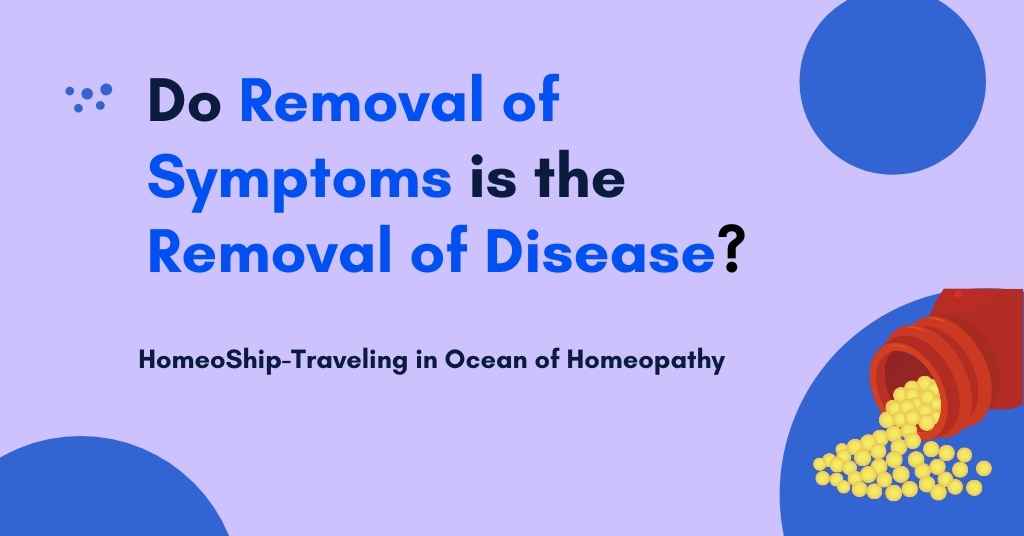Health is a condition of man where he is in a state of ease and comfort, a condition where there is no complaint from a man regarding his environment. This is a state of a man where his body, mind, and soul are in harmonious condition.
Usually, in healthy condition, no symptom is noticeable, health is a “negative state”. Only the sick organism can produce the symptoms. Symptoms are the external manifestations of the internally deranged vital force. We can call the symptoms as the cries of vital force. So, it is a fact that in diseased conditions we can find symptoms and never in health.

The disease is the positive state with the symptoms. To understand the clinical approach of Hahnemann the following fundamentals are important:
- The only way to understand a disease is by symptoms.
- The sickness is for the whole person and not only for his organs. Organic derangement is always secondary to the primary derangement of vital force due to any miasmatic influence.
- Only based on the collected totality, we can either diagnose the disease or find a similimum.
- In this process of selecting a homeopathic remedy, we entirely depend on the peculiar, characteristic, individualizing symptoms of the patient and not on the common symptoms.
- The homeopathic remedy should never be selected based on only one symptom, but it must be selected based on the qualitative totality alone.
So, clearly, we can say that only the deranged vital force produces symptoms, as the harmony of the body is lost in diseased conditions. Deranged vital force exhibits or expresses the symptoms with the help of the organs. Our aim is to treat the symptoms of the vital force to cure the disease in a rapid, gentle, and permanent manner.
The disease is subtle because it is dynamic in nature. The disease process cannot be understood, but only the end results of the disease are easily understandable or demonstrable. The derangement that has started in the organism is reflected in the form of symptoms and nothing else.
Hence the only way to understand the disease is by studying symptoms. In spite of this easily understandable approach to disease and the holistic concept of the disease, the old school physician ‘Hufeland’ criticized,
“Homeopathy can remove the symptoms but the disease remains”
How illogical it is? When the totality of symptom is the only indication of the manifested disease, then the removal of the totality of symptom in its whole extent must be the only way of curing a disease. When the entire totality of symptom is removed without leaving any trace of the single symptom with the well-being of the person, it has to be considered as cure and restoration of health.
The orthodox school treats the disease in a one-sided symptomatic manner. They aim at treating only one or two symptoms that are more troublesome to the patient. Their way of approach is either palliative or suppressive treatments. Thus, they only aim at partial removal of symptoms and not in the removal of the totality.
Hence, by the allopathic treatment, the patient recovers from the disease for a relatively shorter period, whereas the disease remains in its own place. Even if the patient recovers from one disease, it happens at the cost of a new disease, whereas the curative procedure of homeopathy aims at covering the entire symptomatic totality of the patient without leaving any trace of the disease.
Prescribing only for the pathological symptom is not the aim of any physician; he must always try to remove the cause of the disease and not the pathological end products of the disease. The cause of the disease is always dynamic in nature and not any materia peccans. The dynamic derangement of the vital force by the dynamic morbid forces is the only cause of the disease.
Dr. Kent says “Morbid anatomy furnishes no basis for prescribing, but true pathology is often of the greatest benefit, helping the image of sickness to shape itself before mind.”
Dr. E.T. Lee says “As a part of this totality the pathological state is known and given its full value it deserves, as something outside of and separate from the totality it has no place, nor function save to do harm”.
Dr. Garth Boericke says “the more the symptoms the better will be the prescription”.
From the above comments, it is clear that the disease is nothing but the collective whole of the symptoms, and its cure is not possible by removing one or two important symptoms. But the cure is only possible by removing the totality of symptoms that is the only indication and source of understanding the disease.
“Removal of the totality is the removal of disease”
The old school considers the absence of pathogenetic microorganisms and the absence of tissue damage as a cure. But on the contrary, homeopathy considers a person healthy only when he is not only free from any pathological and functional problems but also enjoys a state of mental, social, and psychological well-being.
Hence, as an answer to Hufeland’s criticism, we can say that totality of symptoms is nothing but the entire disease picture, both in physical and spiritual planes. When the prescription is based on such totality and the remedy is covering the entire picture of the disease, in such conditions based on the law of similia, removal of the totality is nothing but the removal of the entire disease in its whole extent and nothing else.
Hope you understand today’s topic! if you have any doubt you can always ask us in the comment below. Follow us on LinkedIn for more updates.


Wow, amazing weblog structure! How long have you ever been running a blog for? you made blogging glance easy. The total look of your website is wonderful, let alone the content!